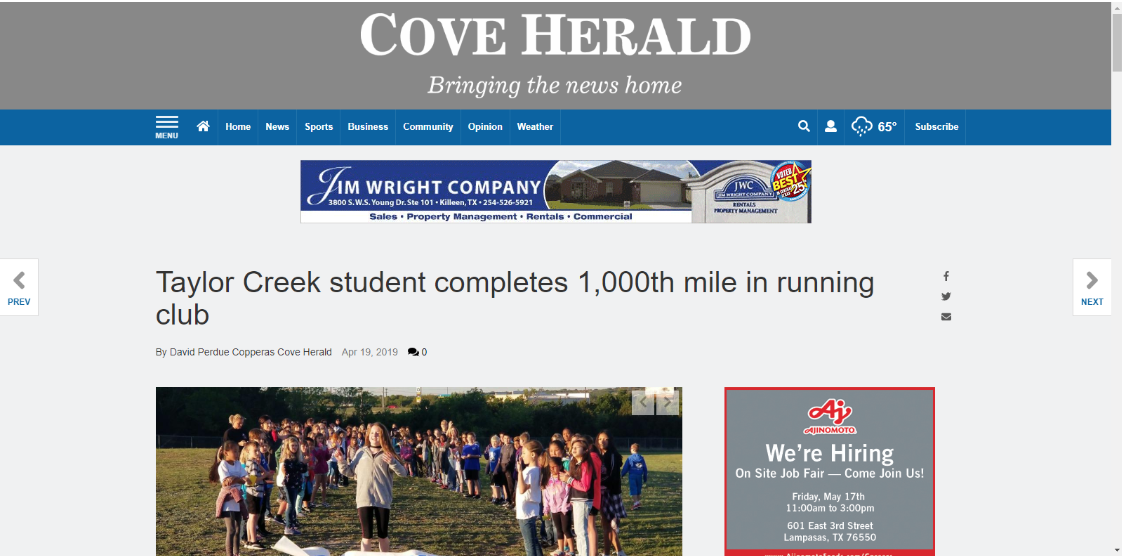Case Study: How Nonprofits Should Pitch a Human-Interest Story
Did you catch the story about Kelbie Black? This 10-year old girl from Austin, Texas made the news for running 1000 miles in three years with her local Marathon Kids running club. It’s a great human-interest story and also a great example of how nonprofits can get media attention.
Marathon Kids is a nonprofit that organizes running clubs for kids across the country. Their program gets kids to run the equivalent of four marathons each season—that’s 104 miles!
Kelbie, however, kept going. Tracking each tenth of a mile, she surpassed all her peers and logged more miles than anyone else in the nation-wide program.
Full disclosure – Marathon Kids is my client. When they told me that Kelbie was closing in on her 1000th mile, I contacted the media to let them know.
This was a huge opportunity to get media attention for Marathon Kids and Austin news publications were eager to tell the community about such a cool kid setting goals and achieving them. Soon enough, national publications picked up the story, too.
As reporters told the story of Kelbie Black, they also told the story of Marathon Kids’ mission. This generates more interest in their programs on all fronts. They can use this success story for fundraising, attracting new kids to join, and encourage those already in it to keep going.
When I work with nonprofits, I always look for this kind of human-interest story. I like to serve the media with a story that is truly captivating. Human-interest stories are more likely to be told and retold, which means more media attention for the cause.
So, if you are a nonprofit in need of some media attention, I recommend pitching a human-interest story!
Here are a few tips.
1. Find Someone Who Represents Your Impact
The most important part of your pitch is going to be who you choose as the subject. Make sure they are on board with being in the media in the first place and are comfortable telling their story.
There are a lot of different types of nonprofits so it is challenging to generalize who should be the subject of your pitch.
For Marathon Kids, it’s pretty straightforward. Kids are the ones who benefit, so pitching a story about one of these kids makes sense. The story about Kelbie Black was great because she totally embodied the Marathon Kids mission of being active, setting goals, and achieving them.
But let’s say your nonprofit is about planting trees. In this case, you might be able to pitch a story about an endangered species of trees, but it would probably be more compelling to combine that with a story about the community that benefited from having more trees.
In any case, look around your organization and see who inspires you. Most likely, that person will inspire the media too.
2. Focus on Local Media First
It’s really tempting to go straight to the New York Times, but I promise you, the local media is much more likely to be interested in your pitch right away.
And as local publications start to talk about your human-interest story, the chances of being picked up by national publications increase.
Local media is typically a lot easier to work with and you should capitalize on it. If I’m pitching something local, I try to include words like “Local” or mention the name of the city or neighborhood in the subject line of the email. This way they know right from the start that this is relevant to their readers.
3. Ride the Coattails of the Human-Interest Story
…not the other way around.
I know it can be hard to let the story take center stage while the nonprofit stands in the background. But even though it’s a little counterintuitive, this strategy is absolutely necessary if you want the story to go far.
If you try to inject your brand in front of the story, the media won’t be as interested. They’re not there to promote you, they’re there to report the news and tell good stories.
But if you can let the human-interest story take the lead role, you might be surprised at how much exposure and interest your nonprofit will gain. You’re still a big part of the story and most likely, they will mention you anyway.
Plus, everything that’s published about the human-interest story is content to build your credibility. You can leverage media attention by linking to these articles and news stories on your website. Then, when someone visits your site and sees the media talking about your work, they’ll know you are the real deal.
This is one of my favorite parts of PR. When a nonprofit gets media attention, it does wonders for their credibility and can be really powerful for their cause.
If you are interested in learning more about how to pitch your nonprofit to the media, consider a workshop where I go way beyond tips like these and train your team how to be their own publicists.



